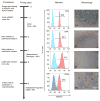Directed Endothelial Progenitor Differentiation from Human Pluripotent Stem Cells Via Wnt Activation Under Defined Conditions
- PMID: 27590162
- PMCID: PMC5075968
- DOI: 10.1007/978-1-4939-6393-5_17
Directed Endothelial Progenitor Differentiation from Human Pluripotent Stem Cells Via Wnt Activation Under Defined Conditions
Abstract
Efficient derivation of endothelial cells and their progenitors from human pluripotent stem cells (hPSCs) can facilitate studies of human vascular development, disease modeling, drug discovery, and cell-based therapy. Here we provide a detailed protocol for directing hPSCs to functional endothelial cells and their progenitors in a completely defined, growth factor- and serum-free system by temporal modulation of Wnt/β-catenin signaling via small molecules. We demonstrate a 10-day, two-stage process that recapitulates endothelial cell development, in which hPSCs first differentiate to endothelial progenitors that then generate functional endothelial cells and smooth muscle cells. Methods to characterize endothelial cell identity and function are also described.
Keywords: Chemically defined; Endothelial cells; Endothelial progenitors; Growth factor-free; Human pluripotent stem cells; Serum-free; Small molecules; Wnt signaling.
Figures



References
-
- Kaupisch A, Kennedy L, Stelmanis V, et al. Derivation of vascular endothelial cells from human embryonic stem cells under GMP-compliant conditions: towards clinical studies in ischaemic disease. J Cardiovasc Transl Res. 2012;5:605–17. - PubMed
-
- Van der Meer AD, Orlova VV, ten Dijke P, et al. Three-dimensional co-cultures of human endothelial cells and embryonic stem cell-derived pericytes inside a microfluidic device. Lab Chip. 2013;13:3562–8. - PubMed
Publication types
MeSH terms
Grants and funding
LinkOut - more resources
Full Text Sources
Other Literature Sources

